
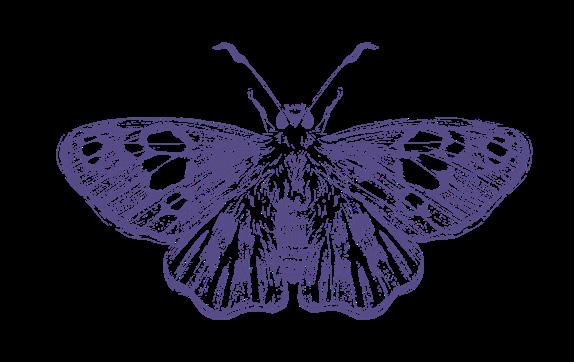


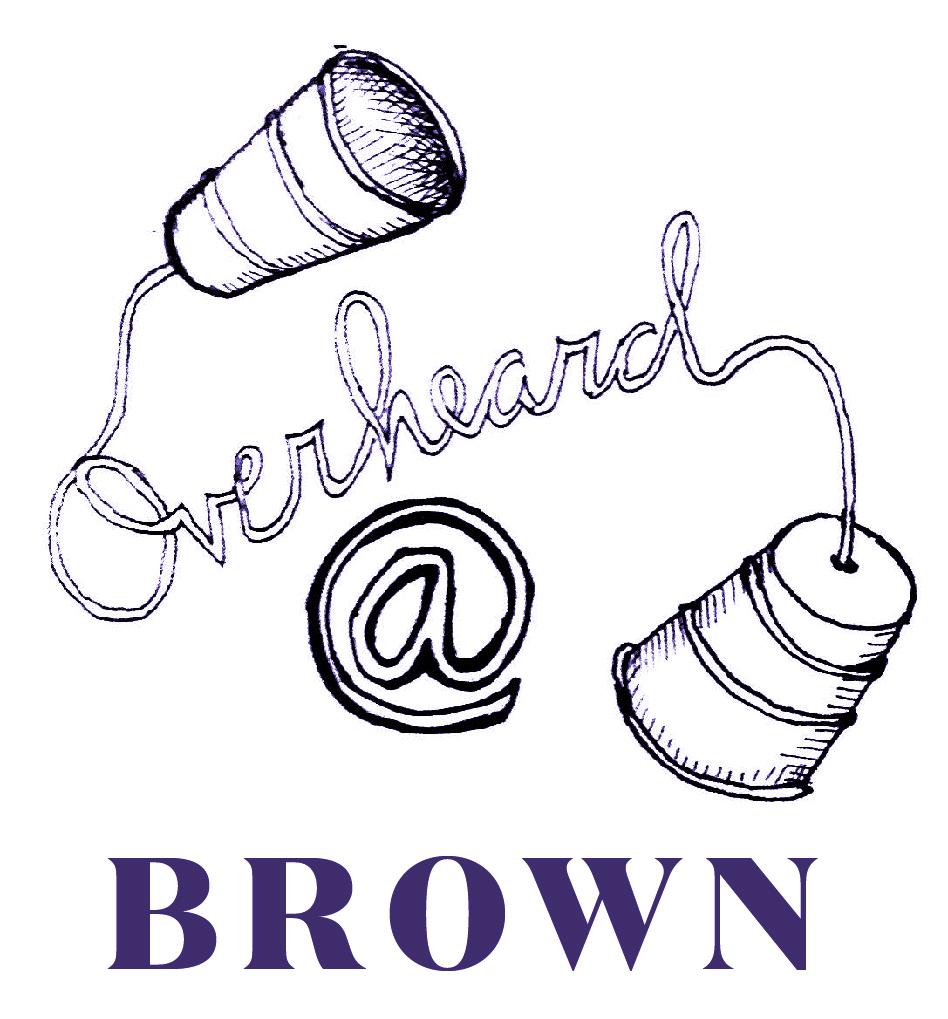
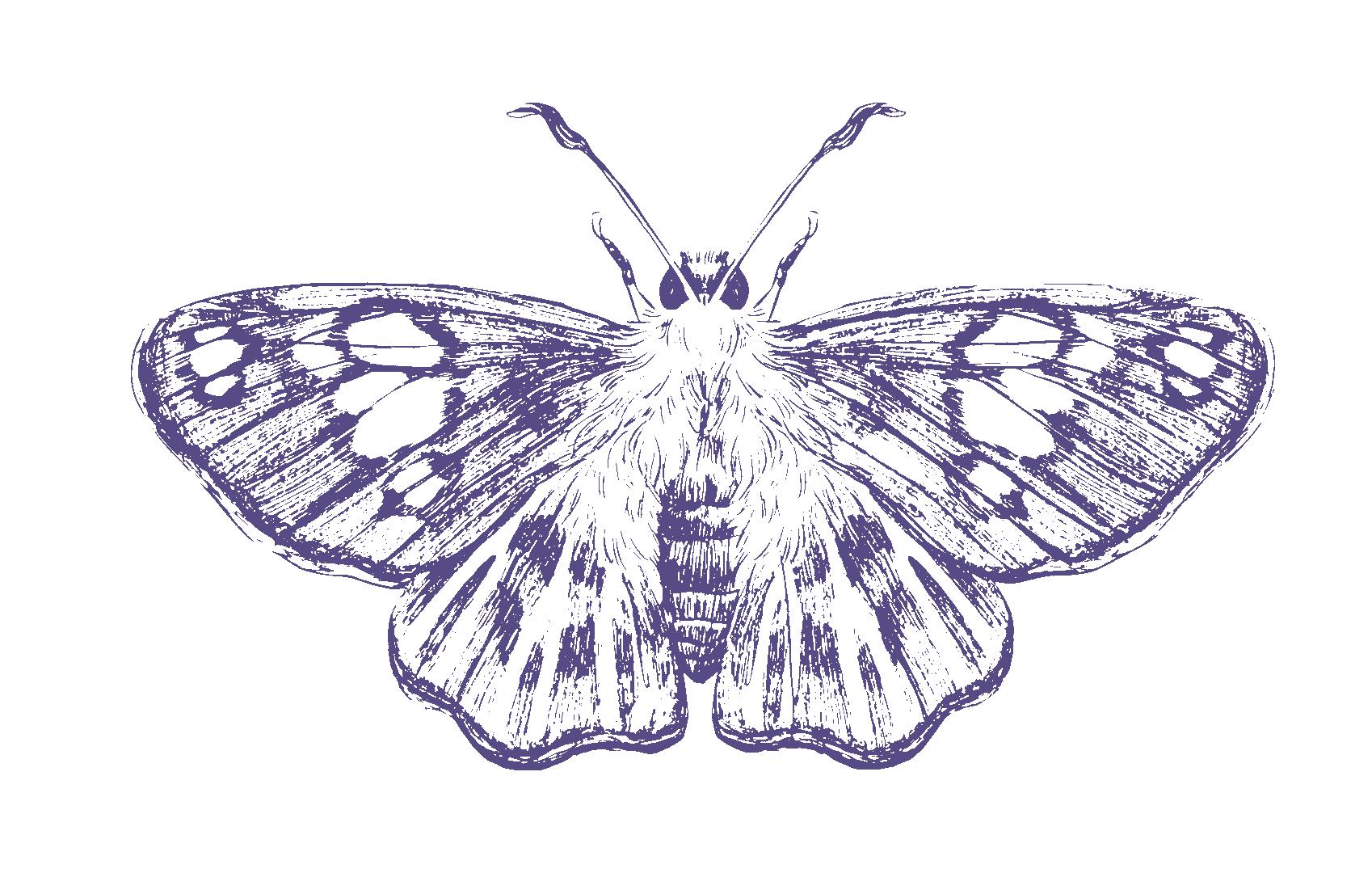







Dear Readers,
This October, and this semester in particular, I’m learning to pace myself. I’m trying to grow out of the habit of outrunning my old self, and that begins with letting all feelings pass. I can’t help but drag and then tumble over my own feet, staring at the fall foliage that eventually drifts down, or place my hands over my mouth to simply pause—at first, the sickly sweet smell of caramel, and then the paralyzing sight of the new apple pie ice cream from Kow Kow. Yet, with slowing down comes the great responsibility of confrontation. I’m (actively) relearning to love time alone, spending most of my chilly weekday mornings at Coffee Exchange, warmer evenings on an East Bay Bike Path run, and the coldest nights laughing with friends over a game of Guess Who? In this issue of post-, our writers
are also uniquely playing with time. In Narrative, Mar revisits childhood memories accompanied by a magical fairy, while Vanessa seizes the busyness of a whirlwind day. In one Lifestyle article, Ina gives us cool dishes to cook up in the Ratty. In the other, we have our first managing editors’ piece of the semester (!!), commencing the spooky season. In Feature, AnnaLise dives into the pacing of long runs and beyond, while Audrey moves through memories with her family. In A&C, Ozzy reflects on Fleetwood Mac’s live “The Chain” performance, while Johan dissects various aspects of Azealia Banks’s social media presence. In this week’s post-pourri, Selena’s comic highlights the pull between studying and still making time to be creative. Finally, check out Lily’s crossword on celebrities! As I leave October admiring all of the various writing and art pieces that call post- home this week, I’m inspired to begin recognizing the small changes in myself as positive. There’s something really special about learning to make time for ourselves and our loved ones, in whatever way we know best. As the fall season comes into full force, I hope you find solace by reading each piece—truly the best way to pass the time.
Walking down Wickenden,
Gabrielle Yuan
Narrative Managing Editor
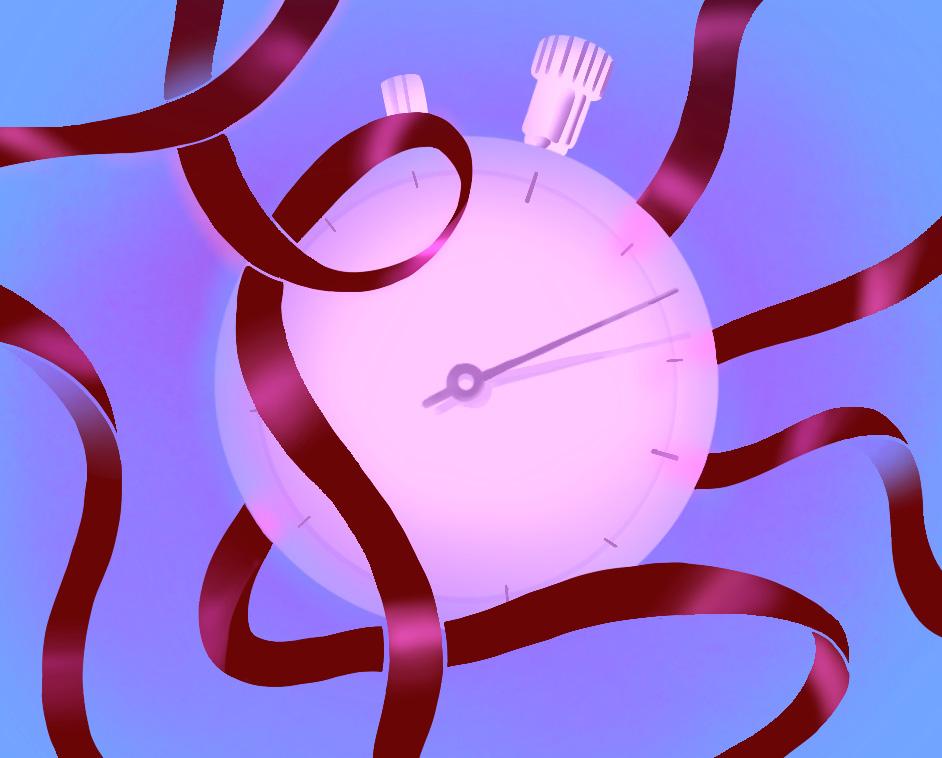
by Annalise sandrich
For the past three years, my family has upheld the same end-of-summer tradition: On a Saturday in mid-August, we drive four hours north of San Francisco until we hit Eureka. On Sunday, we run the Humboldt Bay Marathon.
There’s a workout called the progression run, in which you gradually increase your speed over time. The progression run is a question of control, of discipline. Can you force yourself to go slow in the beginning when you know you’re capable of going much faster, when your instinct is to pick up the pace? Can you push yourself to go faster in the end, when it’s much harder to do so than it would have been in the beginning, when your body wants to slow down?
At the core of the progression run is the concept of negative splits, or running the second half of something faster than the first. Most studies agree it’s physiologically the most optimal way to tackle a big race. Saving your fastest miles for last means that you better conserve the glycogen you need to fuel your running, that you improve your thermoregulation, that you reduce lactic acid production, that you transport oxygen to your muscles better, that you delay fatigue.
And, as one running coach puts it in Trail Running Magazine, “How you run a race is just
as important as the final result. If you’re able to finish in a way that makes you feel good—if you can finish strong—you’re much more likely to consider the race a success and feel more fulfilled by your performance.”
I grew up surrounded by marathons. By now, my mother has run over 60 of them. She has literally lost count of exactly how many she’s done. She once ran three in the span of 13 days. This was something sort of incomprehensible for the vast majority of my life, in which a 5K was a difficult, rare, and weekend-consuming event. As an unathletic child, and later teenager, I would ask my mother how her races went. Her reply was often a critical one—“too slow, not what I was hoping for.” Having no concept of what was “good,” I always wondered at how she could be self-deprecating moments after completing 26.2 miles. Even after I’d started running marathons of my own, when my mother disparaged her own considerably faster times, I’d always ask, “How could you ever consider that slow? How could you ever not be proud?”
My mom ran the 5K and 10K in college. Her coach didn’t allow her to run marathons while in season. I think she’s grateful for it now. Since she started running them years after graduating, she doesn’t have to compare her
current times to those of a younger and faster version of herself.
My mom says that I am getting faster and she is getting slower, and that one day our lines will cross in an x—hers a negative slope, mine a positive one. She’s 57. Age does objectively slow you down at a certain point, but she’s wrong about herself. Last year, she ran her fastest time in over 15 years—three hours, 22 minutes. A few months later, she did it again. She seems to forget this fact every time she runs something slower.
My mother was with me for my first marathon: Humboldt Bay, 2023. The charm of Humboldt is something you have to experience to fully understand. The drive up is half of it— simple yet gorgeous, roads tracing the sides of the mountains, coursing through thick patches of redwood trees, stretches of nowhere that feel almost holy.
At the end of it is Eureka, at the very top of the state right before you hit Oregon. Marked by its colorful purple and green Victorian homes and a quiet path along its coast, it’s small and quaint, much like the marathon that runs through its downtown.
The marathon starts at 7 a.m. on Sunday. About fifty or so runners congregate at the
start line—much fewer than most marathons, lending the event an almost casual, run club feel. The morning usually starts out at about 55 degrees with a cloud cover that burns off by the time you’re done running. Ideal conditions.
That year, it didn’t matter what time I got, so long as I made it the whole way through. Your first marathon is your fastest by default. The minute I crossed the finish line, the daunting goal that had once seemed an unattainable achievement of my mother’s suddenly became doable all along.
My mother might have been more excited than I was. With a medal hanging around my neck, donning me a marathoner, she turned to me and asked if I would do another one. Before I could properly respond, she answered for me: yes. Yes, you have to. There was something of an implied statement of encouragement: You finished so strong. You could finish even faster next time. And I knew it too—I could do better. I could train smarter, race harder.
For many runners, the Boston Marathon is the ultimate goal. I can’t remember when it became mine. It’s easy to say it was the second I crossed the finish line for the first time at the 2023 Humboldt Bay Marathon, but back then I hadn’t even been sure I would run another one at all. What I do remember is when the dream truly solidified into something concrete.
My mom runs Boston almost every year— she has over 20 successful finishes under her belt. Last April, two weeks before the Providence Marathon, I took the MBTA and then the T to mile 20—the base of Heartbreak Hill, the beginning of a brutal climb Boston is infamous for—equipped not with Alphaflys and a Garmin, but instead with a big green dinosaur balloon and my loudest cheering voice.
She was, as she often is, unhappy with her result, as it wasn’t the PR she’d been hoping for. But the day before, I had accompanied her on her shakeout run (a brief and easy run before a race) on the path along the Charles, marveling at another New England spring, blossoms bursting from the trees along the river. I could see why it is her favorite race to run, in spite of her disinclination towards hill training (which she has passed down to me). We were immediately joined by crowds of people all doing their shakeout runs at the same time. It practically felt like a race of its own. I even saw a couple spectating, cheering on the shakers with foam fingers.
My mom looks forward to Boston every year because of the energy of the crowds on the sidelines, the consistency of signs that line the whole course, and the fact that so many people she knows and loves run it every year too. The way that, for just one Monday a year, the sport envelops the entire city, the marathon and Boston completely inextricable from one another, perfectly entangled. Schools give the day off. Dozens of streets close down. Everyone watches. In the elevator back to my mom’s hotel room after the marathon, medal hanging around her neck, sweat clinging to her pink tank top, someone asked us if we’d both just run. She assured them confidently that, “She’s running it next year.”
Stating it as a fact felt arrogant, but for the first time, Boston 2026 seemed like it was actually within reach. It was the first time I’d seen firsthand what my mother had talked about for years. It was also the first time I’d
finally gotten close enough for it to be possible.
To get into Boston, you have to qualify. But even that is usually not good enough.
Boston registration involves submitting race results from a certified course during a four-day application period in September. In order to apply, you must hit Boston’s qualifying times, which are announced about a year or more before race registration opens. These are simple. You know what time you’re shooting for well in advance of the race you try to qualify at, and you either run fast enough, or you don’t. The standards for Boston 2026 were five minutes faster for each age group than they were in 2025—for my age group, a 3:25, down from a 3:30. In Providence, two weeks after spectating the Boston Marathon, I ran a 3:22:56—my first ever Boston qualifying time.
Usually, though, more people meet qualifying standards than Boston can accept. Marathoning’s popularity has spiked in recent years. And so, each application cycle, you must make the “cutoff”—an amount of time subtracted from the qualifying times for each age group depending on how many people qualify. There is no way to know what these will be before you submit your registration application. 3:22:56 is not a huge buffer from 3:25—but it’s within the range of possibility. It would have made the cut for any other Boston Marathon, but things get more and more competitive every year.
Providence, though, is a course with some elevation gain. Humboldt Bay is not. My mother reasoned that if I was capable of a 3:22:56 on a hillier course, I could certainly run a sub-3:20— which would give me a safe buffer—on a flat one.
With the rate that I was improving, it seemed like she could be right. My time at Providence was a 15-minute PR, run with another very negative split. The last six miles of any marathon have always been my favorite part. The moment when the end is in sight, when you know you have more to give, when you feel like you’re improving each and every mile, when you know that this race will be better than the last one.
My third Humboldt Bay Marathon was a little different from years prior. For the first time, I spent most of my summer outside of California. By then a two-time survivor of East Coast winters, I had yet to experience what I had, erroneously, considered a kinder season. As it turned out, summer is a monster of its own. Long runs in heat waves meant that suddenly “easy pace” didn’t feel so easy anymore. My breezy jogs along the foggy bay were replaced with treks beneath a vindictive sun that beat down like a weighted vest, like worn-out shoes, like a miscalibrated treadmill. Everything is harder in the heat. I began to miss the days of trudging through February slush with sleet in the air and fingers too cold to move.
Temperatures, conspiring with a few minor injuries, an insufficient recovery period after Providence, and a general lack of will, meant my training, my goal time, and my general confidence that I actually enjoy running faded from the forefront of my mind. Degree by degree, the months and then the minutes slipped away.
At the familiar start line, my anxious, quick heartbeat a harbinger of the real drumming to come, I had no idea what to expect of myself. My speed work had gone out the window. And
then, arrogantly, there was that pulsing hope still coursing through my body. What if what if what if. Make it to mile 20, and you have it from there. You know you always have it at mile 20. But once I started 22, the seconds and then the minutes began to drag out. Slower and slower splits. Nausea that didn’t die down when it usually did, after the bullhorn. Dead legs that screamed I was a failure. There’s a popular saying in the running community: Positive splits for positive people.
But that’s not how getting slower feels. It feels, at best, like a miscalculation. At worst, the realization that you think too highly of yourself—that you don’t know yourself as well as you once thought you did.
And at the start line all those miles ago, what did I know myself as? A negative splitter, or a fast finisher, or an improver? And when had that changed from that unathletic girl who stared at my sweat-drenched mother in awe and thought her medals were impossible? And what would that girl have thought of me now? What would that girl have thought of a failure at mile 22? There’s a popular piece of advice from a novel by Samuel Beckett: Fail better.
That’s exactly what I did. For the first time ever, I ran my second-fastest marathon. For the first time ever, I ran a marathon and did not get better. Instead, I commiserated with my mother, who also did not achieve her sub-3:20 goal that day. Instead, I crossed the finish line, for the first time, defeated. Same town, same race, different drive home.
There’s a psychological phenomenon: We gravitate towards linear progress. We lose the forest for the trees; we lose the good races in the bad. We want to feel like our careers are progressing, like we’re getting better job offers and promotions than we got last year. We want better test scores, better grades this term than the last one. We want to earn more in Q2 than in Q1, and we want our writing to be better than it used to be, and we want better mental health, better relationships with the people around us, better love lives, better style, better fitness. We want to feel like we’re improving. We want that simple drive up or down, the one without stops, the one without navigation. We want the progression run, each mile faster than the last.
And there’s the obvious truth that life is no perfect Strava bar graph, no ruler-straight trendline pointing up. And it’s obvious to the little girls watching their mothers, and it’s obvious to the little girls watching their older selves become failures tens of miles farther than they ever thought they could go at all.
Of the 33,249 qualifying runners who applied to compete in the 130th Boston Marathon, 24,362 were accepted. I wasn’t one of them. There’s a modified quote I’ve repeated to myself since my “Notice of Non-Acceptance”: fail faster. And that’s not the phrase that was going through my mind when reading the email, and it’s not the way I felt at mile 22, and it’s not how I’m going to feel after most of my positive split runs, my moments of deviation from the trendline. But it is how I feel setting my sights on Boston 2027, knowing the cutoff times will continue to get more and more competitive, hoping that I get faster faster than they do. And it’s exactly how I feel knowing that my mom will race a 3:20 someday, even if she has to run a few more 3:30s first.
by Audrey wijono
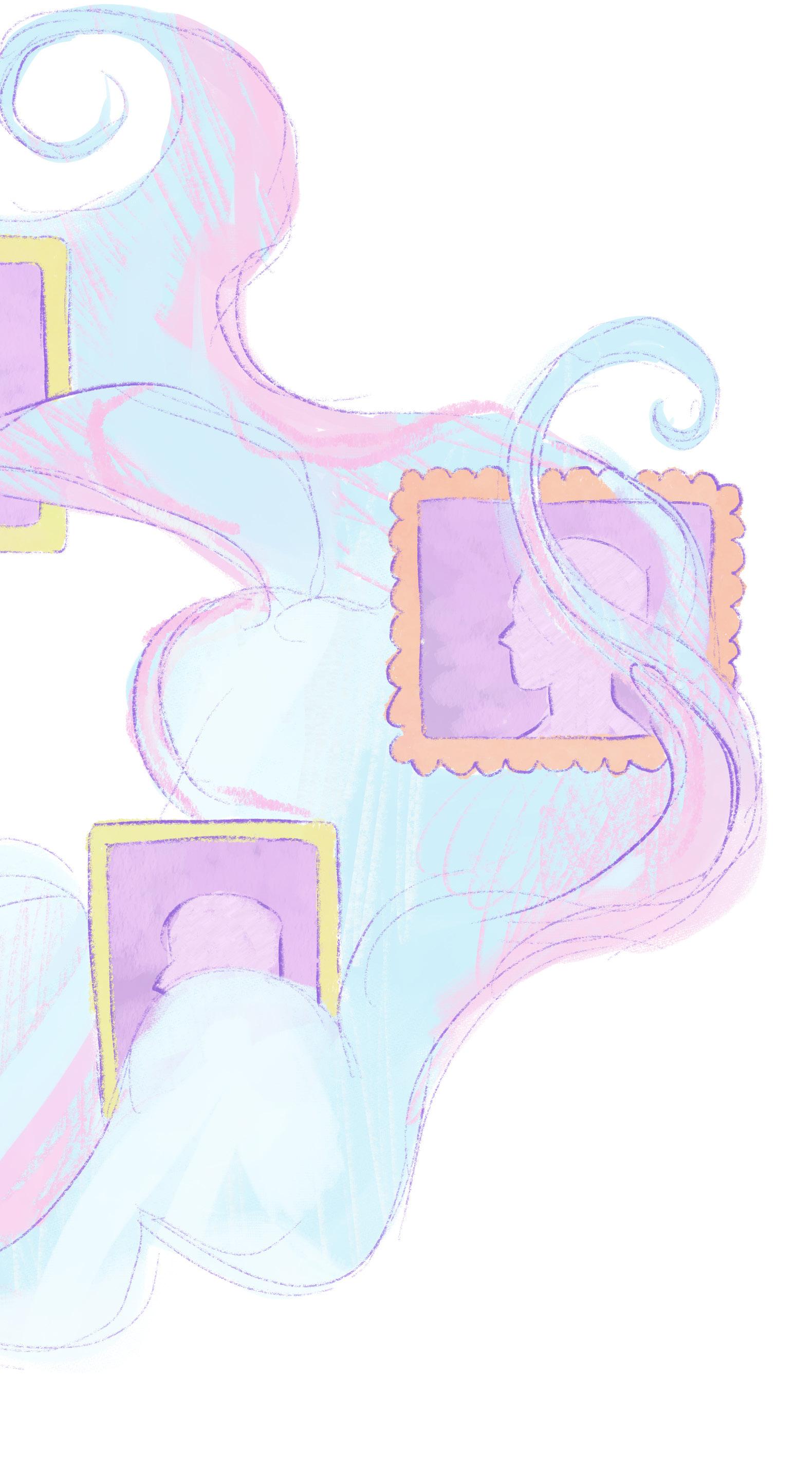
There is an altar in my mother’s family home.
For years, I left the room alone, the closed door foreboding and strange. In a home of hoarders, I imagined it was probably an attic, piled high with belongings nobody could name. I never cared enough to ask, anyway. Between stuffing my face and running circles around my grandparents, I was far too busy to snoop.
It was only after my grandfather’s death that I was allowed in.
I’d never seen an altar before then, at least not one I’d had any personal connections to. Stepping into the room for the first time, my grandfather’s altar feels foreign, lined with portraits of ancestors I’d never thought to view as my own. Logically, of course, they are—I still carry so many of their features—but Thailand is hardly real to me. I don’t know any of my relatives. I’ve never spoken the language. And I’ve only ever been once or twice. Even then, I’d never gone with my grandfather, the man who knew his homeland best.
After my grandfather’s death, his face joined theirs.
For a house that had been falling apart for years, the room had been meticulously kept. Tiles swept, altar dusted, statues shined; my grandfather had cared enough to keep the place—and his ancestors—alive.
The day I am let in, my mother has me kneel and pray. Under my father’s watch, I’d grown up in the Catholic Church and had knelt enough for a lifetime. But blasphemous in my grief, I join her and press my knees to the tile.
We pray, first, to Buddha. My mother lights a pair of candles on the altar. Then, picking through a half-empty box of incense, she lights a stick by the flame.
Meekly, I follow suit. The incense lights up between my fingers, and I hold the stick upright between my palms, trying my best not to let it slip. My motions are clumsy, and the smoke rises in jagged, wavering lines, too disturbed to settle.
My mother bows her head in prayer. I bow mine, too, and keep the silence. The smell of my grandfather—of incense, wafting—lingers in the air the entire time.
After our prayers, we leave the lit sticks behind with a portrait of my grandfather, face still chubby with health. Caught in a collared shirt and tie, the smile on his face almost reads like a grimace.
The smoke joins the lines on his face, rising to swim around the ancestors above him.
Once the door was opened, it stayed that way. Gradually, it became routine to bend, bow, pray.
I go through the motions with the little I’ve been taught, but I’m divorced enough from my mother’s Buddhist faith and my distant Chinese ancestry that altars and altar-making have become foreign acts. Even the prayers I mutter feel improvised and amateur.
Do you pray to your ancestors, or to Buddha? Is there a right way to pray to Buddha? Are you supposed to pray to the Buddha at all?
Untethered, I know so little about what it means to grieve, to remember.
My mother performs this all with ease, but I know these practices will die with me.
My father’s ancestors must have built altars, once, before we’d absorbed the Dutch’s Catholic faith. Even after generations in Indonesia, they were far more Chinese than we ever could be.
Today, their graves are tucked away in our middle-of-nowhere hometown. East Java, in a burial ground for Chinese-Indonesians.
The one time we visit, we bring flowers by the bag, purchased on the side of the road. Blue, like butterfly peas. We toss them onto the headstones and the grass in careless clumps, muttering vague prayers with the motions. In another time, this would have been ritual, imbued with meaning. But for us, it is another sunny day.
My paternal grandfather’s girlfriend comes from a family that is more recent immigrants. She tells us about Chinese cemeteries as we move through.
Chinese graves, she explains, are guarded by a deity, for whom an altar is built at the foot of the grave. According to her, the custom is to pray to the deity and offer incense before paying respects at the grave itself.
We skip the routine. Partly because it would be blasphemy; partly because we hadn’t known to bring incense at all.
The last grave we visit that day is the oldest. It belongs to an ancestor whose name has been worn down over time. There, we leave her wilted flowers and pray with practiced solemnity.
Partway through our silence, my grandfather lets out a cry of surprise.
Someone had built over her altar. The neighbouring plot—grander, from a family wealthier than ours—had cut through the stone to build a staircase to their plot, leaving her with half a deity. Carved through, the stone is pitiful.
“They can’t do this,” my grandfather tells us, rubbing the half-altar with his hands.
Though a gentle man by nature, I halfexpect him to curse, yell, bite. This might be the worst offense of all: to be built over, physically; to be denied space for solace in death.
Instead my grandfather sighs, resigned. I watch him retract his hand.
It takes so little to destroy a sacred place.
I wonder how that affects an afterlife.
My maternal grandfather is brought from
his deathbed in Jakarta to Scottsdale, Arizona, where my cousins live. For this journey, my grandmother decides she will bring his ashes in a Tupperware.
There is no customs declaration form to bring your dead husband into America, and he crosses the land, sea, and sky with ease. He flies across the world before being emptied into a ceramic urn.
When my grandmother washes the tupperware out, particles of my grandfather flow into the pipes and out into the sewage. His body enters the water cycle of the Southwest.
I like to think that he nourishes the cacti, that he lives on in the land.
This, I suppose, makes him eternal.
The next day, the container is used for lunch.
Is it honorable to eat the dead in trace amounts?
My mother tells me she refuses to be buried. Cremation, she tells me, sternly so I do not forget.
I am afraid to tell her that I wouldn’t know what to do with her ashes.
For all I write about my family, grief doesn’t actually hit me very often. Birthdays and deathdays blur into the other blips on the
calendar. The disconnect, though, is always felt. An entire ocean separates us. From here, I have no land or graves or ashes. No altars of my own, nor any knowledge of how to build them. I don’t know what it means to remember or honor when so much has already been lost, razed, or eroded with time.
I worry that we will have no sacred places. That our names and lives will be forgotten, that our lands and bodies and altars will be built over.
To be forgotten by the mortal realm is to wander, untethered and restless.
The afterlife must be tenuous with nowhere to rest your soul.
The sacred, I think, might have to be small.
I’ve never met my paternal grandmother, but I know her well. There was a portrait of her in the living room of my childhood home, smiling and radiant and full of youth. The space, carefully tended, was always hers.
Every night, as the sun set, we’d stop by her corner and turn on a lamp, the bulb offering her a pocket of light.
With us around, she never sees darkness.
Maybe one day I will stop writing about my family.
Or maybe I’ll never stop. Maybe I’ll come to the page forever to light my ancestors’ lamps, to keep them bright in my mind and yours.
Maybe, then, they’ll live on in you, too.
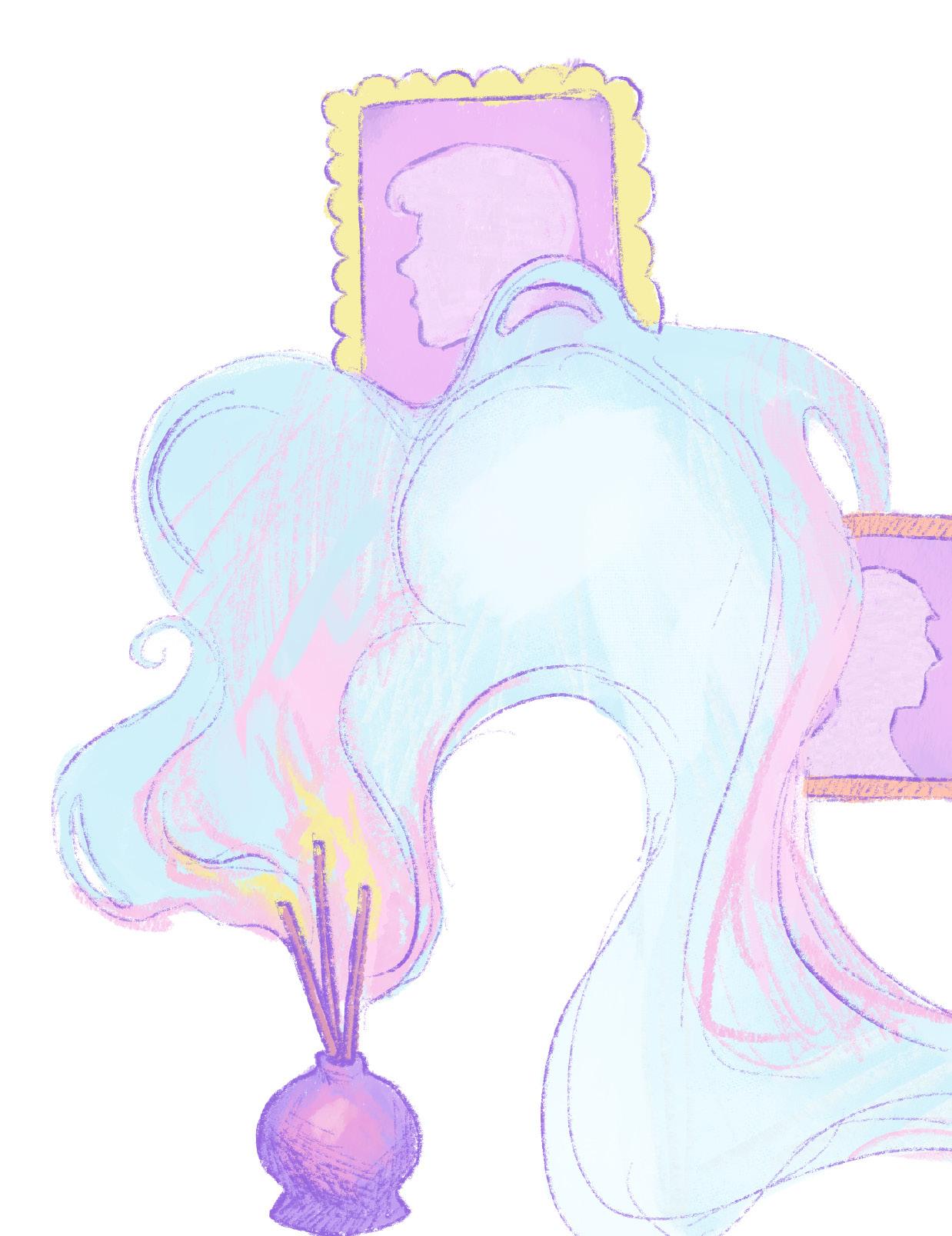
we were all once children
by Mar Falcon
Illustrated by sheryl lee
I stand on the chair, trying to keep my balance. My right arm stretches upwards as I reach for the top shelf, and I carefully grab the heavy box. I place it on my desk and I open it, and there it is: “When I grow up I will fly.” Among all my old hand-written letters, I choose this one to keep reading. “I will have a boyfriend and my sister will love me and I will live in New York and I will be a CEO. And I will fly. Above the sky I fly fly fly fly fly.”
One
When I was five, I believed in magic. You see, my dad once gifted me a fairy and it was the most special fairy in the world. At first glance, it didn’t seem very pretty or unique, and there wasn’t really anything about it that caught my attention. But my dad said this fairy had a secret—it had the power to fly. He promised that every night, while I slept, she could reach even the highest shelf of my closet. So who cares for truth when there’s intrigue and there’s hope. Every time my dad tucked me into bed, I’d be giddy with excitement. In my sleep, I wished to experience a miracle. And every morning, I did—my fairy was sitting on the highest shelf. Not once did it occur to me that someone could have possibly moved it. Not even my dad who, a bit too enthusiastically, would constantly remind me to pay close attention to it.
My fairy became a loyal companion— not only physically, but in spirit. Any time I experienced a situation I deemed unwanted, I closed my eyes tightly and focused on how I wished it would change. I thought that if she could fly, she could do anything, and that if she could do anything, she would come and help me. “Please,” I’d ask. “Let this go my way.” I felt the wish so intensely that there was no doubt in my mind that it would reach her. A heart full of faith.
I once went to the doctor to get a vaccine. I can’t remember which one it was, but what I do remember is being six years old and running around his office for what felt like an absurdly long time. He wasn’t giving up (props to Dr. Javiercito): Mar was getting vaccinated at 8:30 a.m. on that Tuesday. Mar was also crying and running away from him, praying to God—more like her mom sitting across from her—that this evil needle wouldn’t come near her. Alas, who hasn’t been a kid; I kept crying and it helped nothing and the needle went in and it didn’t
hurt at all but I kept crying.
As I was leaving, I asked him when my next vaccine would be, and he said when I turned 10. I remember my relief then, thinking to myself: “Ten is a big number. At 10, I will have no fear.”
Two
I’m in kindergarten. The bell is ringing and it’s time for recess and I’m sprinting across the hallway to get to the costume trunk before my friend does. I afford myself a look back as I run: She’s nowhere near. Great. My top priority every day is to get to the costume trunk before she does, so I can get the pink princess skirt that fits me perfectly. I get there first today, so I am happy because I am a princess.
Fanny and I used to play princess-sisters every day, a game of adventure that ranged from fantasy maps and complex backstories to incredibly specific scenarios we came up with. The skirts were necessary;we were princesses, as I said. Whichever adventure we decided on, the school transformed into an elaborate mythical world in our eyes. We explored mountains, jungles, and haunted houses. We were chased by witches, werewolves, and all kinds of enemies. It was real, I swear. I was there. The swings turned into vines, slides were rivers, and other people became part of the scenery. Only we were real, and even we were fantasy—we could be anyone we wanted.
Another vivid memory comes to mind: biking along the shoreline with my dad and screaming at the top of our lungs and singing our favorite songs. It was the two of us, sometimes my sister too, and I’d be wearing a helmet that was too big for my head while riding the bike or roller skates or the scooter—it didn’t matter. What did matter was the song we were singing together, the strong wind against our faces and ocean smell so salty I could taste it. He always started the song, and my sister and I always followed, and it was nice. It was nice seeing an adult overcome with happiness just from singing out loud. To me, it was peak adrenaline: I felt like nobody could hear us, like we were the only people in the world singing a song by the shore, like we could keep on biking forever, like we were infinite.
Shabbat family dinners, on the other hand, offered a different sense of freedom. It’s a Friday night and my parents are still in love and my grandparents are still alive and no one has moved away and you’re lying down on the most comfortable couch, dozing in and out of sleep. You hear the dinner in the adjacent room, still ongoing: the clinking of the silverware, the background soft folk music, the laughter, the affection threaded through their voices. You feel safe here, at your grandma’s, a house of
love. You know your eyes can—and will—betray you at any moment, and you know you’ll fall asleep and still wake up in your own bed. Or, more exactly, that you’ll be awakened by your mom carrying you to the car, but will pretend to be asleep so she tucks you into bed. A classic. You still live at your mom’s house and your mom loves you and your mom will always tuck you into bed. And you fall asleep in your bed then, for real now, and there are no lingering thoughts, no unresolved feelings, only safety. You’re safe.
Three
We had a beach house, and the beach house had a pool that turned into a multipurpose secret den (yes, a secret den. I know, super cool). The main infrastructure consisted of an inflatable boat that, when turned upside down, served as the roof of this sacred hideout space. My cousin Valu and I composed a hymn for it, choreographed dances about it, and would inhabit it whenever we had to talk about very important things. Like secrets and stuff. The interesting thing is that the hideout wasn’t the boat, but the boat was the hideout once we agreed on it. The den was created by our imagination only. Again, I swear, I saw the world transform completely into a sophisticated secret agent-like building, but only when we were in there. It was meaningful because it was ours and no one else’s.
I still swim in that pool every summer. My sister Olivia, now eight and too young to have experienced the den, has found an alternative worldbuilding technique. On a typical sunny summer day,
she’s already in the water by the time I, 22 now, choose to join.
“What color is your tail?” she asks me.
A part of my brain jumps with excitement at that question. A sign of old remembering, it begs to answer the question, knowing how to please her. I can feel this happening, but I can’t quite place the answer. My first instinct is a logical one, so I’m confused when she asks this question, and yet I hesitate on my answer, just in case it’s logic she’s expecting, in which case I can deliver the most efficient response.
So I just look back at her, puzzled.
“You know,” she says. “Mine is multicolor but mainly pink and purple with glitter and hearts and stars and it glows in the dark.”
She stares at me then—isn’t it obvious? Can’t you see my beautiful tail?
“Oh, right. Yes! Mine is all the colors of the rainbow and glitter too and has special superpowers like being extra strong.” The most efficient response indeed.
She smiles then, welcoming me. I belong in her world now; the pool turns into an ocean, the house into a kingdom’s castle, the animal floats are our marine friends, and we can suddenly breathe underwater.
How does she do it? How did I use to do it?
How can I win the creative race, be a natural at limitless imagination? Maybe if I think of patterns to anticipate her next questions or remember her previous responses, I can be more accurate next time. Maybe if I do some research about children’s speaking tendencies, and I rehearse enough, I can learn to think like them. Yet,
Olivia’s curiosity isn’t rehearsed, it’s natural. Her answers, to her, are obvious. I wish I never stopped playing mermaids. Maybe then I could fly.
Four
As a kid, I was always dancing. As soon as I learned how to jump, I was dancing, and the first time I danced, I never stopped. In every old recording of a family gathering, you can see them all together, and when the camera moves slightly to one side you can see little Mar moving her arms to an imaginary rhythm and turning and shaking her head, always smiling. My grandpa, on the camera, would call my name: “Mar, say hi to the video! Hey Mar, show us your dance moves!” but it was pointless. I was consumed by movement; there was dancing and there was me and there was nothing else in the world.
I was not being watched, or I was, but not judged, and if I was being judged, I didn’t know it. It didn’t concern me—not because of an extremely high self-confidence, but because of my unawareness to the possibility of external perception. It wasn’t odd to be so oblivious to those around me because “she’s just a kid,” they’d say. “She’s just a kid,” so she’s exempt from judgment. Her time for that hasn’t come yet.
Dancing was my life until about four years ago. Four years ago, it began: “Am I good? Am I good enough? Am I among the best? Am I better than the others? Am I doing things right? What do they think of me? Do I deserve to be here?” I guess my time had come.
I made the most of it, though, way before the doubt and the judgment and the self-criticism. Every single day, I would play “Chandelier” by Sia and I’d put on a bodysuit and become Maddie Ziegler. I’d sing as loudly as I could and move my body in any way I thought of. I wasn’t swinging from a chandelier but I might as well have been. It wasn’t just the movement, but it was the feeling that came with it. I used to be so free. I was flying.
I’d fly when I danced and I’d fly when I biked and I’d fly as my mom carried me to bed and I’d fly fly fly fly fly. Every day I would fly and every night I’d dream of flying. I mean it—in my sleep I’d open my wings and aim to reach the highest point in the sky. Here, I remember the wind, again, against my face, as I became one with it. Every single night. I was the only person in the world and I was flying.
Five
A quote from Picasso: “Every child is an artist. The problem is how to remain an artist once you grow up.”
Art is lightness. Art is vulnerability. Art is
authenticity. I used to be an artist.
I’m standing in an empty room, and there is only a frame, like an open door, in the center. Across the room stands little Mar. We’re facing each other in silence. I haven’t seen her in a long time.
Her white nightdress is spotless—did she wear it just to meet me? Her curly hair looks soft—did she shower before coming here? Her lips, that bright red tone—does she know how beautiful she looks?
I shed a tear. I miss you.
She smiles, eyes glimmering.
I smile back, lips pressed together, and give her a wink.
I hear her laugh, still facing me. I think she understands.
Like following an instinct, I try running to her. Just then, the doorframe stops me, a force holding me back, and she vanishes. Confused, I step back, and there she is again, closer now, standing by the doorframe. I reach for her once more, wanting to hold her, but the frame has hardened and gleams faintly, and I can’t cross it. I look at her; she sees me. I hold her stare, looking for approval, and wrap my arms around myself, hands pressed against my back. I open my eyes; she’s doing the same.
I do it all for her. I hope she knows that.
I still think about my fairy: she who created magic. I look out for the little fairies now, too—I truly do. I enjoy all the minuscule unlikely coincidences and I relate them to something deeply personal and I believe the angels are sending me messages, I swear I do, and I think it must be the universe sending a sign because why wouldn’t my fairy be able to fly by herself? And why wouldn’t I?
Like you, I close my eyes when I wish things would go differently and I hope and I pray that I can somehow change them and I believe in magic, I swear I do. I’m a fool, just enough, and I believe my wishes are sufficient, that God or the universe or any bigger force is omniscient and all-powerful and cares and listens if only I wish hard enough.
So I’m a princess and I’m a mermaid and I’m the only person in the world and I open my wings and I’m free to fly and I’m always dancing. See how naive? See how beautiful?
on letting things be what they are
by Vanessa Tao Illustrated by Tarini Malhotra
7 a.m.
Last night, I told myself I would wake up early, but my alarms continued to ring long into the morning. I say last night, but really it was only a few hours ago when I finally returned to my dorm from Boston, weary and delirious, dumping my backpack and jumping under my covers without another thought.
This morning, I sit up, groggy and shadowed. Still reeling from my night in Boston, I get up and start packing to leave for New York. I pick up my backpack, remembering I left my toothpaste in the hotel last night in my rush to check out, catch the train, meet my project partner, lead two club meetings, set up a movie night, and finish my laundry.
9 a.m.
After a brief goodbye to my roommate, whom I haven’t seen in days, I’m in a forest, holding a C-stand in one hand and a Blackmagic camera in the other. Someone helps an actor shove his feet into clown shoes while the director carries the rest of the equipment down to the lake.
Left to my own devices, I introduce myself to this new group of 12. I dive into a story about my summer, pausing at the same places to laugh
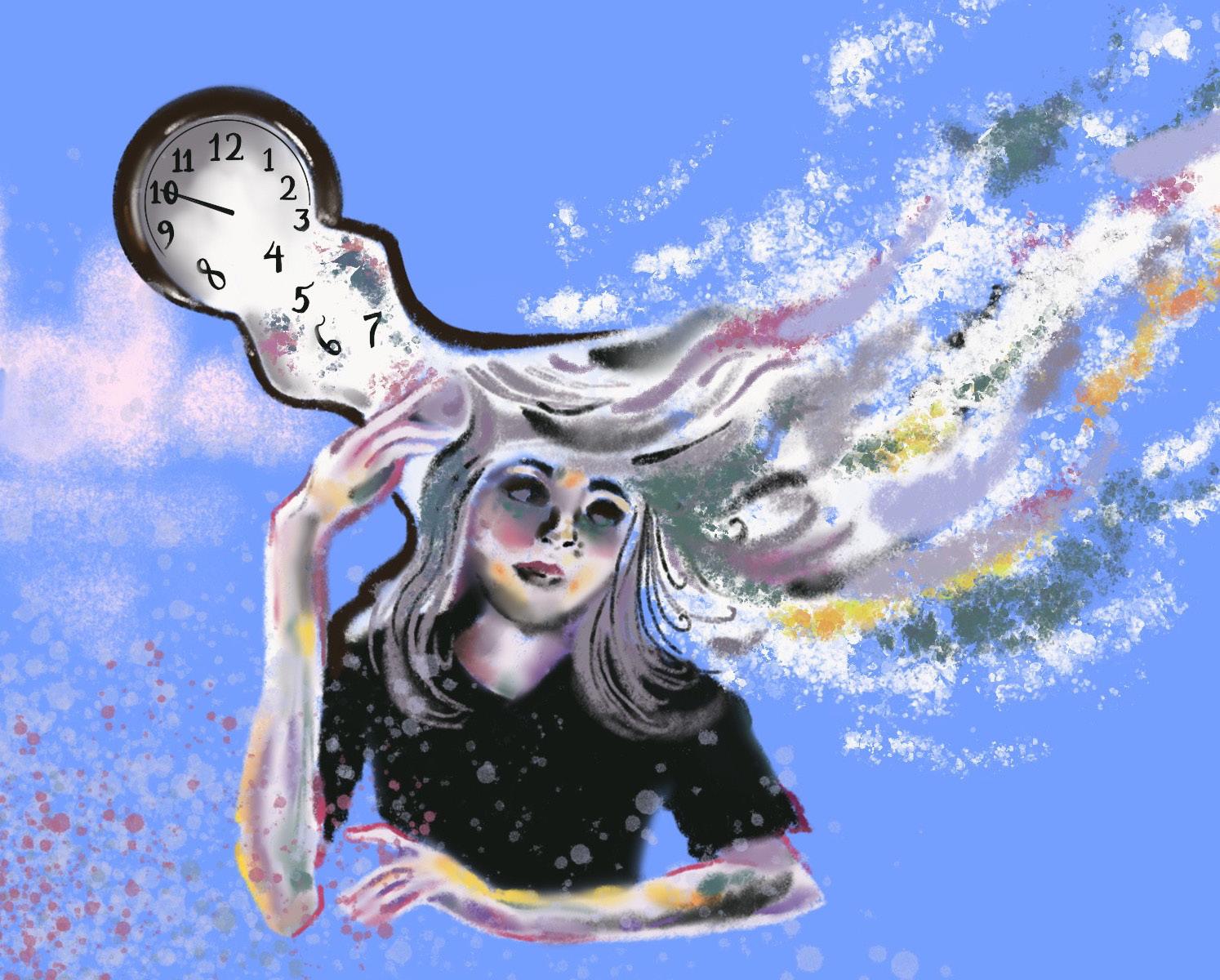
in the same way I did the night before when I introduced myself to a group of 15 in my intern program. I’ve told it enough times that I’m starting to get bored, and while I’m laughing, my mind wanders to what I have left to pack. Considering I still haven’t unpacked, there isn’t much.
12 p.m.
In the shower, I think about how I’m always selling my secrets.
1 p.m.
On the train, I think about how, if I’m in a bidding war, I’ve never won.
4 p.m.
I hug my friend at Penn Station. He has a McDonald’s bag in his hands—the order I’ve been getting since junior year, the order I ask for every time I’m in his passenger seat. I tell him about my train ride, which was just a feverish loop of dreaming about people I think I’ve loved, people I am still in love with, people I loved seeing on my phone (it was a new name with every dream), waking up to every conversation and announcement and squeal of the brakes.
6 p.m.
The steam from the soup dumplings warms my nose while I talk to my friend. My phone is on the table, which is barely big enough to fit our plates as it is. Every time it lights up with the wrong name, the pit in my stomach grows. My friend can tell that I’m not really here.
7 p.m.
During my first Broadway show, Michael Maliakel stands towering over me in an umber three-piece and a scowl, playing a beautiful and tortured Nick Carraway as he stands with his arms outstretched. He proclaims, “It eluded us then, but that’s no matter—tomorrow we will run faster, stretch out our arms farther . . . And then one fine morning—” before he’s drowned out by gold and green dancers, applause roaring through the auditorium. I think about what has been eluding me, about how to run faster, jump higher, reach further, just one more inch, just another hour, just another person, another week, almost there, just a little more and then Daisy Buchanan makes eye contact with me, and I realize I should be standing and clapping too.
2 a.m.
In New York, I drink stolen wine with the McDonald’s friend (the only person on the East Coast who has known me long enough to see me with straight hair), with my new(ish) friend from Brown I have not quite figured out yet, and with a girl I kissed last summer in a different country. Eventually, the wine bottles run out, my two friends leave, and I’m suddenly lying down, looking up at wild curls and sugar-glazed green eyes.
“What’s something you’re afraid to tell other people?” she asks me, legs locked between my knees in her bedroom while sirens and rain harmonize outside.
“Probably… how scared I am to lose them. How far I would go to keep them,” I answer, not exactly making eye contact.
She thinks for a moment, goes silent. She
plays with my hair, mumbles something in my ear that I can’t hear, and tells me that she’s making a mental list of what she likes about my face.
She tells me she likes the shape of my upper lip and then kisses me like I’ll disappear if she stops.
3 a.m.
I text my childhood best friend a poem about her I’d written almost a year ago. It’s mostly to tell her about how “the last time I had you was when I was eight and you / were twelve and we played with dinosaurs and / you still had color in your eyes.”
She tells me she likes it and then adds that she had gotten legally married yesterday. She’s married to someone she met on a Minecraft server almost a decade ago, in between our sleepovers, when we would play the game for 16 hours straight.
We would obsess over crafting the perfect world, building a beautiful cave/tree/lake house, curating a zoo of pets, meticulously constructing railways to each other’s houses, hunting monsters on each other’s horses— hers were always faster—while we journeyed endlessly through the world. Sometimes I wonder if we spent so long in our video game world because we knew our lives in the real one would split apart. I can’t build railways to take me from Providence to Denver in 15 seconds, and she’s too far away now to shoot the monsters behind me while I’m blindly exploring. I settle instead for telling her I’ll fly back for their ceremony, no matter when or where it is.
In my head, I still keep our promise to sip tea on our porch, lifetimes from now, when my hair is white and her back is curved. I still keep our promise to laugh at the kids running down the street, smiling through wrinkles and reminiscing. I make a new promise to remember this one, even if she forgets.
10 a.m.
I say goodbye to the girl from last night, who tells me it’s an anomaly for her to be in her dorm at this time. We live similar lives, dashing from hour to hour like we’re out of time at the ripe age of 19. We do it because we want everything— we want to meet everyone, see everything, experience everything, do everything that scares us.
Stop running yourself ragged, she says. At a certain point, the more you try to do, the less you really live.
She makes me promise to watch the sunset. Locks her pinky with mine, kisses her thumb. I think of what really scares me. I wonder if the world will end when I finally make the time to fulfill this promise.
12 p.m.
In a Blank Street Coffee off of 16th, my friend works on a slideshow the same color as my matcha, my third sage-green drink of the day. AJR blasts in my ears, not exactly by choice but strangely fitting: “Can we pause right here, right now / While everyone I love is still in my house?” It’s called “Dog Song,” a nice coincidence because I had spent last night talking to a friend about how she had to act like
her dog for an assignment.
She said it was meditative. Time would stretch, for hours and hours and hours, until you forgot what you were thinking of and you forgot what day it was and you forgot why you were even on the ground on all fours in the first place. It was a stark contrast to my summer, where I barely spent a day on the ground before catching the next flight to my next city.
I’m exhausted, I tell her. Tired of the life I’m supposedly obsessed with.
She tells me to try acting like my dog. Apparently it felt religious, and she doesn’t believe in God.
1 p.m.
She still hasn’t replied, or more specifically, I still haven’t texted her back because I’m waiting for her to come up with something less dry so we can resume our continuous, threeweek-long text conversation. I met her three weeks ago, and when we stopped texting, the withdrawal hit hard enough that I learned what a tension headache was for the first time. I told my friend it was the weather because I was too scared to admit how much it hurt that another little magic bubble of Me + Girl had popped. Too annoyed to admit how it hung, overcast, over the entire weekend, even though it was realistically just another person in a long string of people I’ll meet, start craving, and then quit cold-turkey before jumping into something else.
A neon pink sign in a cafe window tells me to stop micro-dosing on love.
4 p.m.
We’re in a lounge, technically a piano room, but there’s a chart defining Credits and Assets scribbled on the music staff, and profit-maximization formulas instead of key signatures, so I decide to call it a lounge.
I’m silent, because my friend just asked me why I’m sacrificing so much to keep this girl in my life. What’s it worth, he’s asking me. I thought the answer was obvious—it’s always the same story, after all. She’s a good person, we’re friends, we have good conversations, etc. He should know. He’s heard it before.
I know I’m silent for too long, because he looks at me again and tells me that my sanity is worth something too.
11 p.m.
On the way back to Brown, I’m in another Uber with strangers I turn out to be connected to—we go to a small school. I contemplate texting someone once I make it back to my dorm; I know half my friends are awake, but I'm too exhausted to hunt for yet another warm place that isn't mine to hover in.
Tomorrow, I will crawl out of my bed, take Vitamin D if the sun still isn't out, and start fulfilling the promises I’ve made as if they're fireflies flickering through the rain—small and weak, but a direction to start stumbling towards regardless.
For now, though, I’ll drift to sleep with nothing but crickets in my ears, blanketed by the heavy acceptance of knowing the next sunrise will come, no matter how far I fall or how fast I run.
tapping into the heartbreak, once more
by Ozzy Wagenseil
Illustrated by Christina xu
There’s no mistake that a simple kick drum can make you sway. A four-on-the-floor beat, with some hi-hat on the off-beats, makes anyone nod their head, no matter the genre. But with Fleetwood Mac, their drummer, Mick Fleetwood, adds some flare to it in the form of wind chimes. These ringing metal rods add something mysterious. A familiar glimmer. It’s something ethereal, mixed with a heavy presence that you can’t turn away from. For a reunion show on the 20th anniversary of the widely-acclaimed album Rumours, it’s a captivating way to start their most notable song, “The Chain.”
Fleetwood Mac continues to be one of the most renowned rock groups of all time, even though they formed nearly 60 years ago. However, the Fleetwood Mac that you’re thinking of isn’t the original lineup. Formed by electric guitarist Peter Green in 1967, Fleetwood Mac started off as a blues rock group in Britain, with drummer Mick Fleetwood and bassist John McVie as the two constant members of the group from the start.
By 1974, the group’s membership had changed greatly. Peter Green had departed from the band, and even with many rotating singers and guitarists, they had no one to fill the roles permanently, despite the addition of keyboardist Christine McVie, John McVie’s
wife. Then, Mick Fleetwood stumbled upon Buckingham Nicks, a folk rock duo. The pair joined Fleetwood, with Stevie Nicks taking lead vocals and Lindsey Buckingham playing guitar. This is the lineup you definitely know.
With chart-topping albums like Fleetwood Mac and Rumours, the band leaned into a pop rock sound, resulting in many timeless songs and numerous critical accolades—but this lineup cost the band its functionality. Nicks and Buckingham—their romantic relationship shattering—were now feuding with each other. John and Christine McVie divorced, Fleetwood had an affair with Nicks, and Christine McVie had an affair with the band’s lighting director. This aggression, betrayal, heartbreak, and attraction is best encapsulated by one of their biggest hits, “The Chain.” It’s the only song that credits every member of the band as a songwriter.
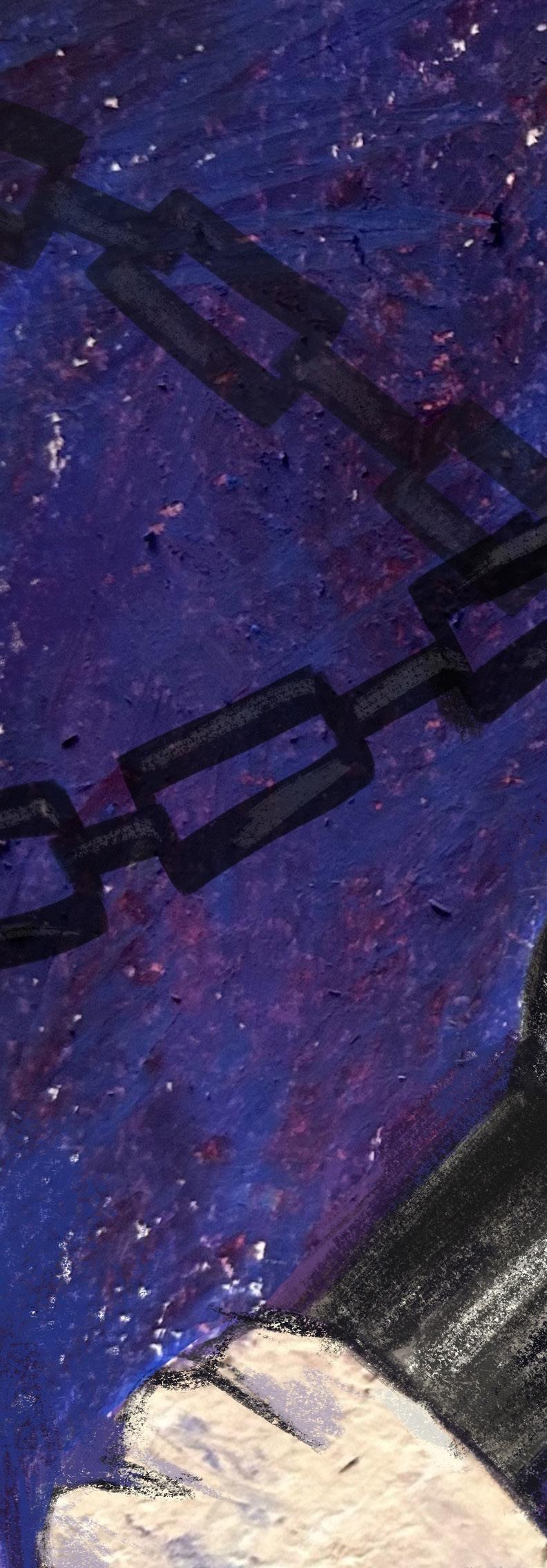
being Stevie Nicks, dressing like a witch that you don’t want to fuck with.
With lyrics that exude struggling to stay together as a band (“Chain, keep us together”); heart-wrenching vocals by singers Christine McVie, Nicks, and Buckingham; an isolated, memorable bass lick; a minimalistic, but aggressive, guitar solo; and just complete raw energy…it’s one of my favorite songs of all time.
So, how could they play it again with that same captivating energy 20 years later in their official reunion show? Well, they don’t. Their
When Buckingham plays guitar, you notice it’s in a lower pitch than the studio recording. The song is played a full key down from usual—D minor instead of the original E minor. This change was likely made to accommodate the aged singers’ vocal ranges. It’s more distinct, but it makes the song sound…almost Western? The lower-pitched guitar is more twangy, combined with the simplistic drum beat. It’s a cool spin. And Fleetwood is already dressed for the part.
And then, the opening lyrics: “Listen to the wind blow, watch the sun rise.” Compared to the studio version, this rendition sounds more inyour-face and bold. The studio does a great job
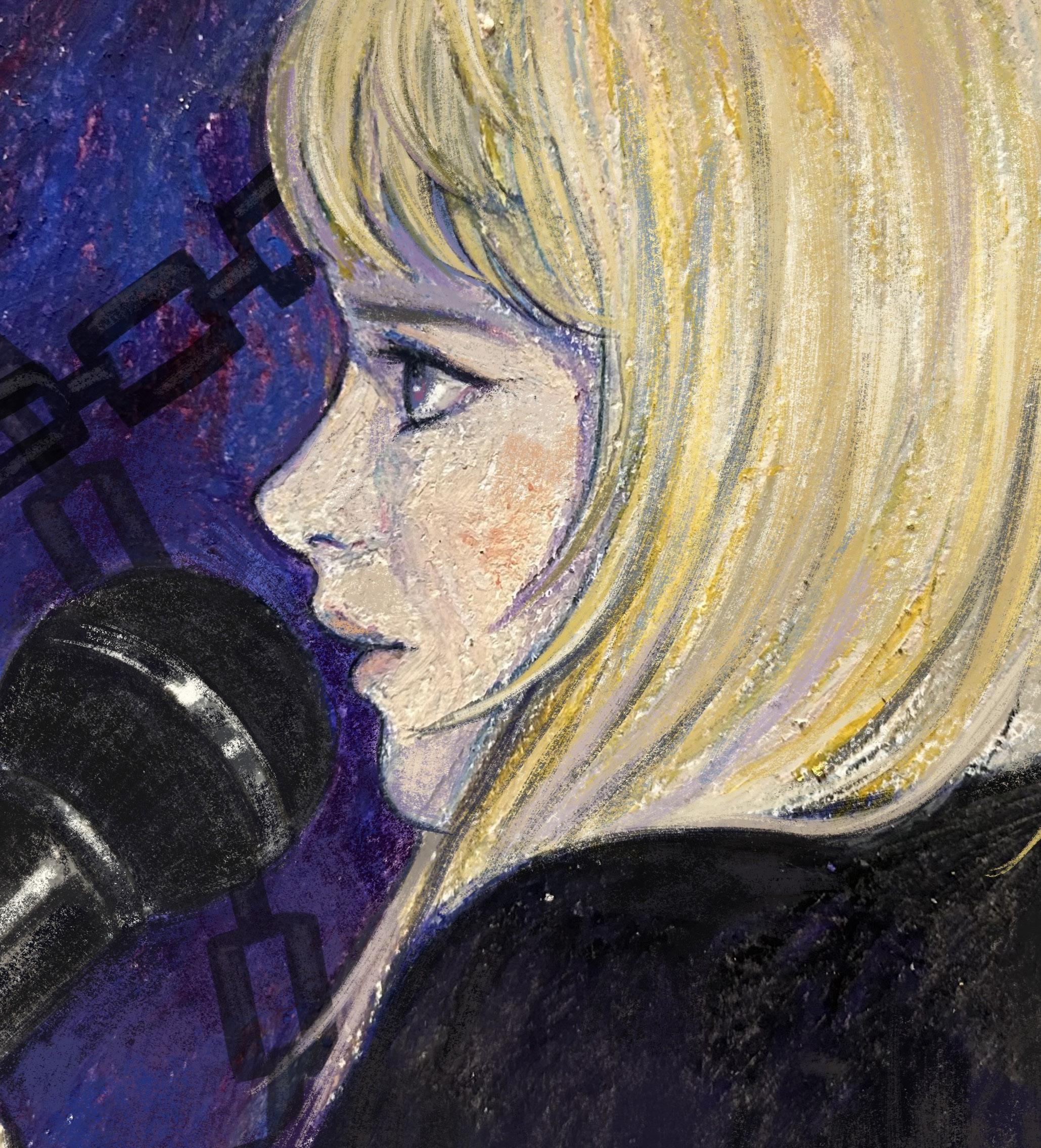
and staying together through the pain of a tumultuous relationship.
Now’s a good time to get this out of the way: Yes, this is the same concert where Nicks sings “Silver Springs” and stares daggers at Buckingham, like everyone and their mother keeps talking about on social media. We get it. This is happening here, too! And honestly, with the way the band starts off the set with this eye contact, I feel like this song builds up to the intense staredown in the “Silver Springs” performance later in the show. Plus, I think “The Chain” is a better song. So, there you go. As the second verse begins, there’s this weird singing thing that Nicks and Buckingham do that I can’t not mention. Nicks repeats the last phrases of some of the lines, going, “the
shoutout to Christine McVie for providing killer vocals while adding an enticing organ that uplifts the hit number. Matter of fact, everyone is doing great here instrumentally. John McVie and Fleetwood are killing it in the rhythm section, and Buckingham’s guitarwork is crazy, finger-picking good. There’s a reason why he’s regarded as one of the best guitar players of all time, with his innovative melodies and etheric guitar tone. The whole stage is immaculately set, everything looks perfect, and there’s no doubt it’s a great rendition of an amazing song. But still, it’s just a great performance, which isn’t a bad thing. It’s 99 percent of the way there. It just feels like something’s off, something’s missing.
The lights start to dim, Fleetwood
exploding into that iconic solo.
It’s perfect. This isn’t the 1977 version of the song that represents the harsh environment of the band’s dynamics. This is nostalgic. Are the band members still feuding with each other 20 years later? They cleaned up their acts, for sure, with fewer drugs in their systems and new marriages. But if you want to make a song like “The Chain” stand out, you have to tap into that source again. Just like how Nicks was staring at Buckingham as if it was 1977, the roar of this guitar solo suddenly snaps the band back together. They’re in sync, tight to the rhythm, and the fights, breakups, and breakdowns of their infamous history are laid bare. That’s how you hold the chain together.
by Johan Beltre
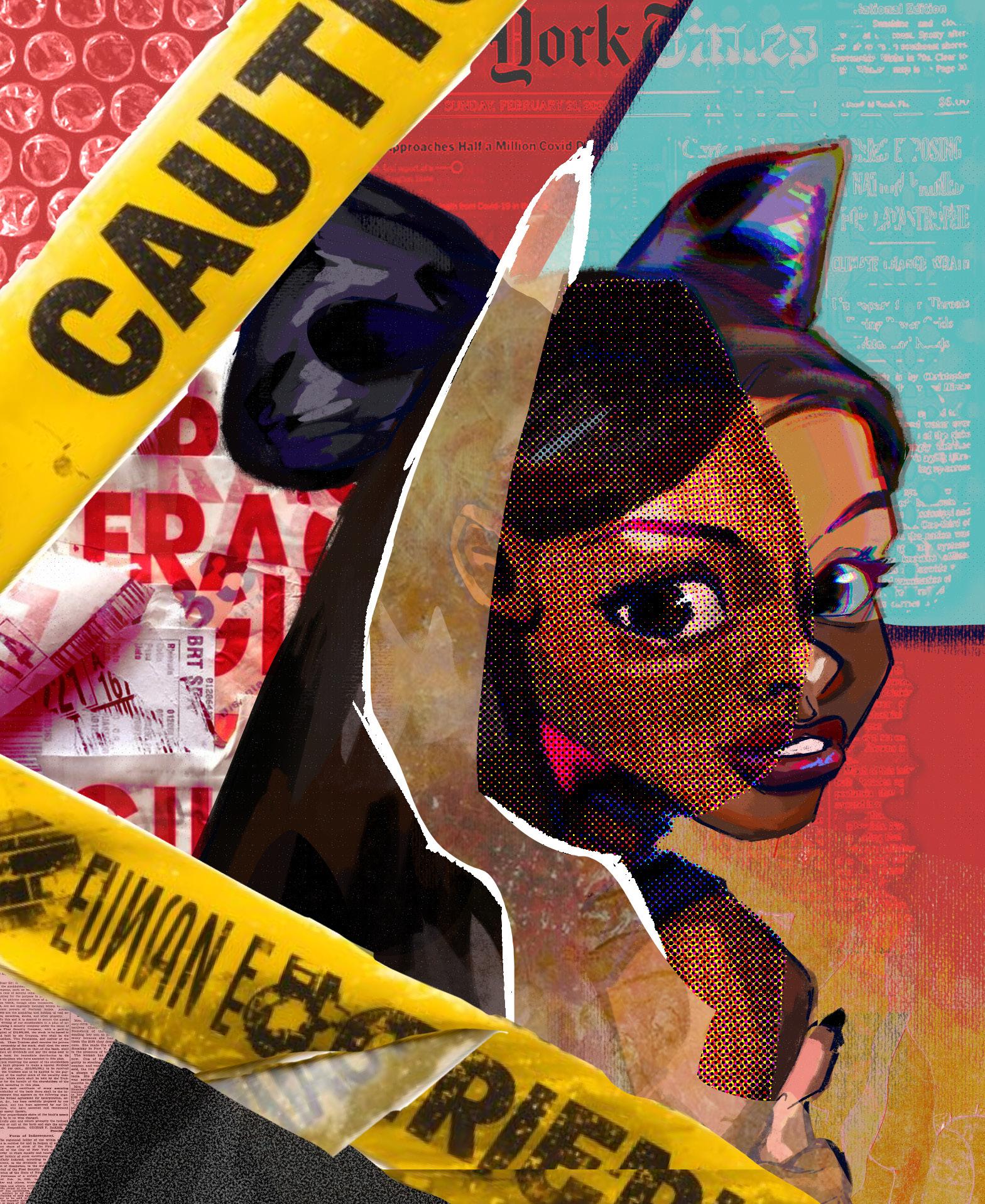
If you’ve ever had a Twitter account or are in touch with popular culture in the US, you have definitely encountered the controversial character that is Azealia Banks.
Sometimes comedic, many times offthe-rails, she always finds the time to make a Twitter thread or a series of blackout stories ranting on Instagram at 3:00 a.m. about current pop culture topics. From entire countries like Ireland to unproblematic artists like Bebe Rexha, no one is safe from getting dragged by Azealia Banks. In fact, I am almost sure that if I were to post this on Twitter and tag her, I would get a taste of my own medicine; she is known for searching for tweets and posts about her and responding to them. Sometimes there is nothing to do but take her rants in, as her breakout hits like “212” and “Luxury” are reminders of her potential as a performer and a lyricist. However, in recent memory, her offkilter opinions and scarce musical output put into question how much I can support, or at this point, even enjoy her past music.
Growing up in Harlem and moving through a short-lived career in acting and performing arts, Azealia started releasing music under the name “Miss Bank$” around 2008. She released a few singles—one of which, “Gimme a Chance,” gained online traction and turned the heads of household names like Diplo. This led to a developmental record deal with XL Recordings, one she would end up losing a year later.
After losing that record deal, Azealia struggled to break through in the music industry, going back and forth between Toronto and New York, making music and working at a strip club to make ends meet. During this time, she pivoted back to her real name and released her official debut single, “212.” This track took the electronic underground scene by storm, giving her the platform to become one of the most well-known rappers of the 2010s.
Her rise to fame as a self-made artist made Azealia a relatable character, an underdog who became popular because of her pure talent and ambition. However, this image quickly became complicated as she started getting involved in unnecessary drama with peers like Lil’ Kim and Iggy Azalea (whom she famously called her albino child she randomly gave birth to in prehistoric Pangea). These hilarious unprovoked altercations shaped the way she was perceived in pop culture at the time, hindering some of her appeal and likability.
During a famous altercation on Twitter between Azealia Banks and Lana Del Rey in
2018, Lana expressed her frustrations with Azealia, pointing to her slow decline as a prominent figure in alternative music spaces. Lana posted, “Banks. You could have been the greatest female rapper alive but u blew it,” likely referring to how her controversial opinions and affinity for starting conflict with whoever crosses her path have gotten in the way of her becoming one of the most respected female rappers in the industry. This is crucial as Lana was one of the first public figures to support Azealia, featuring her in a remix version of her song “Blue Jeans.” If people who were there for you since the beginning of your career are now turning on you because of your behavior, maybe you should reflect inward.
Even so, Azealia is viewed by many as a misunderstood character, ostracized because she expresses her opinions unapologetically. This is relevant when you consider her positionality as a Black woman in the music industry during the 2010s. Black artists, especially women, in the music industry are often subject to subjugation, predatory record deals, and public shame. Society seeks to control how they express themselves in both their music and in the media, based on how they feel about the artist at that time. In Black Noise, sociologist Tricia Rose, now a part of Brown’s Africana Studies department, talks about the ability of rappers and their personas to articulate the ever-changing terms of Black marginality, in contexts like censorship in American society. She writes, “Even as rappers achieve what appears to be central status in commercial culture, they are far more vulnerable to censorship efforts than highly visible white rock artists…[They] experience the brunt of the plantationlike system by most artists in the music industry.” That same culture of censorship Rose highlighted in 1994 still echoes today, where Black women like Azealia face public backlash and erasure for speaking or behaving in ways that disrupt societal comfort.
This is most notable when considering Azealia’s incident involving Russell Crowe in 2016, where she was physically and verbally assaulted at a dinner in his LA hotel room. The general public was quick to dismiss Azealia’s testimony, deeming her unstable and overreactive, and even deserving of what happened to her, just because of her controversial opinions. Equating running your mouth and hurting your fingertips from typing so much to being deserving of abuse and mistreatment is a perfect example of how the general public treats and interacts with female celebrities. They are positioned in a complex dynamic with their audiences, where there is a need to act in ways that are deemed both socially acceptable and entertaining. If you deviate from one or both, the general public is quick to turn its back and rescind its support. This leaves artists with a need to please the masses, even if
that means putting authenticity and reality on the back burner. Azealia has always been bad at this, leaving her subject to retaliation and mockery that can often cross the line of critique and turn into an inhumane force.
As of late, things have only gotten worse with Azealia. She spends her days spewing anti-Palestinian rhetoric and supporting Israel, even performing in Israel as recently as a few days before this article was written. She has become a professional ragebaiter who seeks to destroy the musical legacy that she could have cultivated. It enrages me to see how her views have turned more and more problematic over the years, which makes me question: why do I even bother to listen to her music anymore?
A classic case of separating the artist from the art could work for me. I’ve done it with artists like Roísín Murphy, an electronic music pioneer whose 2023 album Hit Parade dominated my playlists that entire year, after she made transphobic remarks against the use of puberty blockers on transgender children. However, Azealia’s case is a bit different because her music has become less than favorable. If you dive into her recent catalog, there’s not much to enjoy. Her latest official release, “Dilemma,” is a disappointing, sometimes laughable, attempt at UK grime that leaves you with the urge to cleanse your ears by playing anything from her 2012 EP, 1991. In that EP, her sleek delivery and clever wordplay, reminiscent of ballroom MCs, give you a taste of what could have been one of the most influential artists in modern pop culture. You cannot have damaging opinions and bad music in my book. At this point, I don’t see the point in showing her any grace. If she were to focus on her artistry instead of entangling herself with drama that has nothing to do with her—if she were to put that phone down—Azealia would be an unstoppable force in the music industry. Instead, she chooses to sell questionable soaps for her brand CheapyXo (known for not shipping their products even months after sale) and menacing Twitter by making disgusting remarks towards almost every minority group known to mankind.
I have now become indifferent to her meanspirited opinions, her potential as an artist, and her feuds with other public figures. Whenever she appears in my life, whether it is in my Twitter feed or at the club, I enjoy and hate her. Some days, when her music plays at a friend’s house party, I can tolerate it; other days, I find the time to drag her in my public stories on Instagram. She has become a troubled, fleeting memory. A cheap perfume in your drawer that you see every day but choose not to use. A laugh. A case study for this article, instead of the “greatest female rapper alive.”
by Ina Ma Illustrated by JJ Li
Instagram: @by_jjleee.png
My father says meals you make yourself always taste the best. When I was younger, I would laugh at his statement as he served up tangy tomato egg stir fry or hearty beef noodle soup for dinner. Why would I want to cook a meal when I could enjoy the delicious flavors someone else made for me? But the more familiar I grew with the kitchen, the more I began to understand.
I first learned to cook scrambled eggs—an easy breakfast for a middle schooler, spiffied up with sauteed onions or scallions sprinkled on top. Pasta became another staple: a simple and versatile meal. On a whim, I could mix boiled sausages, canned tuna, and peas into it, depending on what my appetite demanded for the night.
As knowledge grew, so did responsibility. I found myself cooking breakfast for the family on lazy Saturday mornings or whipping up a carb-heavy meal for my brother after his evening swim practice. My cooking became an expression of love when I put my energy and consideration into those I was serving.
There was something delightful in the freedom of dreaming up various add-ins to spice up my dishes, to appeal to the various palettes at the table, or to use up whatever was available. This led to many successful (and failed) experiments, from applesauce in steamed baos to hamburger patties in Chinese stir fry.
Since moving into college, I find myself missing the feeling of dough beneath my nails as I move between Andrews and V-Dub. I have explored the full capacity of what the Ratty has to offer and now bring you one of my favorite fall delights, for all my chefs and chefs-to-be.
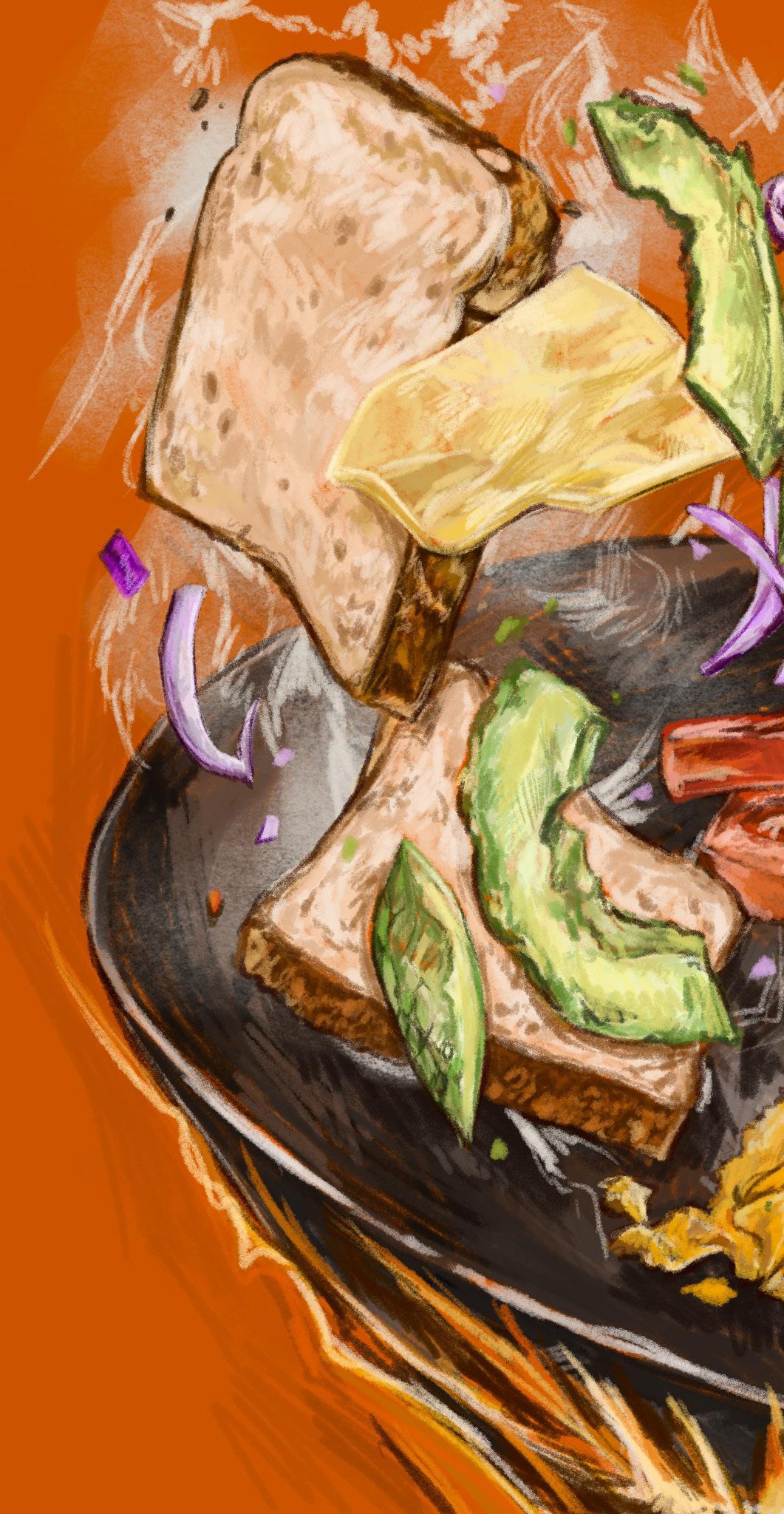

avocado toast panini
note: weekend breakfast ratty bar only
2 scoops of avocado (you will have to ask for extra!)
1 scoop of lox cream cheese (optional) sliced tomato sliced onion
from sandwich station:
2 slices of whole wheat bread
1 slice of provolone cheese
scrambled eggs
set a bagel station toaster to the lowest setting and run both pieces of bread
spread avocado onto one slice of bread. layer on (in order, from bottom to top): scrambled eggs, provolone, sliced tomato, sliced onions, and the other slice of bread.
press in the sandwich station panini
remove & enjoy!
optional: spread lox cream cheese on top of the completed panini.
spiced iced cold brew latte
nutmeg & cinnamon from oatmeal bar
drizzle honey around the sides of your add 3/4 whole milk. add 1/4 cold brew.
sprinkle nutmeg & cinnamon to taste. stir & enjoy with a straw!
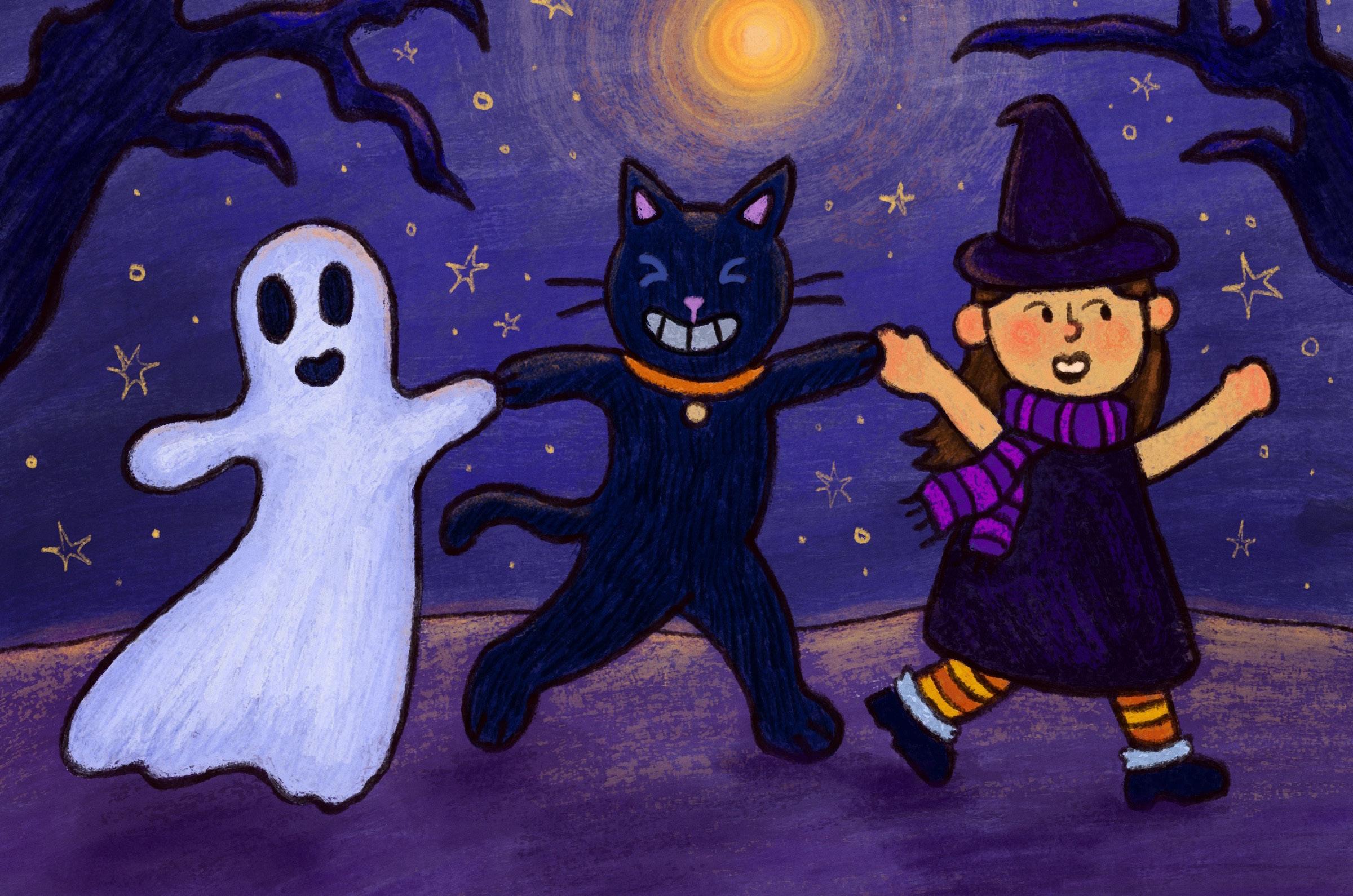
by Managing editors
Illustrated by Orla Maxwell
Instagram: @eight_of_ponds
my attic and i by
Elaina Bayard
I grew up with an attic in my room, and I hated it.
There it was, right above the door to my bedroom: some portal into a monstrous, dark dimension. The string to tug it open and unleash all its horrors taunted me. If I laid on my left side as I went to sleep, I could stare at it, tracking its movements. And I did. When sleep took me at last, I trusted my army of stuffed animals to keep me safe. If one ever went missing, I would assume they had fallen in some epic battle for my safety.
Now, my fear seems quite silly. I’ve been in my attic more times than I can count. I had even been up there as a child. But something about it haunted me. Maybe it was the long shadows, difficult to parse for a girl who hadn’t yet been given glasses. Maybe it was the awful screaming sound the ladder made. Maybe it was my hatred of bugs.
Maybe it served as a symbol of my lack of privacy, since I could have my precious alone time interrupted if anyone needed to get up there. Maybe it served as a symbol for the unknown, since anything could be hiding up there when it was closed.
Or maybe I just liked to make up stories, and I was never really scared at all.
playing dressup by
Gabrielle Yuan
I often find myself in fear, and in contemplation, of dressing more casual than warranted. Most of the time, my daily curated outfit leans more towards being slightly too uncomfortable to sit through a day’s worth of class. With the colder weather approaching, out of necessity, I’m beginning to experiment with the clothes I have. Many staple tops are similar: sleeveless with thin straps, and specifically since this summer, too many shirts with accented collars.
To counter an East Coast winter, I’ve purchased countless cardigans to mix and match with the thinner tops, in hopes of resourcing outfits fit for all four seasons. I’m left unsatisfied: always a bit too cold sitting near the library windows, or buzzing, slightly warm, on the campus steps.
While not a revolutionary discovery, I’ve decided to right this situation by beginning to layer. Coming to this conclusion on my own, I ventured down to Savers, thrifted long sleeved white and black shirts—hoping to find new color combinations, trusting that I can pull off jeanon-jean textures, and have someone, maybe a stranger, notice this subtle, yet internally significant change.
My determination to begin dressing out
of convention and into my own comfort extends to Halloween. I’m done resting in half-fear, half-heartedness to pull together an outfit that balances effortlessness with overthinking. This semester marks the month, the week, the day for me to lose the fear of being seen.
All feelings pass in October—moving into my own costume, in and out of season.
who’s afraid of jane eyre? (it’s me) by AJ Wu
When my oldest cousin went off to college, he did away with childish things—his dusty ziplock bag filled with Game Boy cartridges, his Pokémon cards, and his three stacks of illustrated, abridged classic novels adapted for very young children. I adored all three hand-me-downs, but the classics were, undoubtedly, my favorite. (And if I, between the ages of seven and 11, ever told you that I’ve read Great Expectations, what I meant was I read a version of Great Expectations where Miss Havisham speaks American English and everything is neatly resolved within 80 largeprint pages max. Sorry.)
All to say: In my formative years, my greatest fear was my illustrated, abridged, children’s Jane Eyre. *Spoilers* for Jane Eyre, but there’s a pivotal
scene where Jane discovers that Mr. Rochester’s wife, Bertha Mason, is locked up in his attic. My book contained a pencil sketch of Bertha standing over Jane in her sleep, dripping candlewax onto her face. In retrospect, it probably wasn’t a very detailed or realistic drawing, but still, it haunted my waking and sleeping moments for years.
Too scared to pick up the book with my own hands, I asked my mom to rid our household of this evil by throwing it in the trash at once. She acquiesced after not a small amount of confusion. Life carried on and was good, for a time. Several years later (I’d rather not reveal at what age), I encountered the book again while digging through the back of a cabinet, and—after recovering from my profound betrayal and terror—dropped it into the recycling bin. A wrongfully killed ghost come back to haunt, exorcised once more.
Reader, I’ve heard that acknowledging your fears is a first step on the journey towards conquering them. I’m older now. At 21, I’ve conquered every other fear a person can have and will ever have. Now that I’ve set myself free through the telling, maybe, one day, I’ll finally finish the illustrated children’s Jane Eyre.
the haunting of the bathroom stall by
Daniella Coyle
Moths have always freaked me out—no— terrified me. I have often tried to find reason for this. Maybe it’s something in their uneven flight, their fragile wings that reflect the light in lurid, flickering distortion. Maybe it’s an even stupider thing, like their name’s similarity to the ever-terrifying maths. Or maybe it’s that there’s nothing at all to be scared of, and yet they nonetheless start in me a tremble of disgust and a need to get away. That’s the reason they call fears like this irrational, isn’t it?
Middle school is a pretty nightmarish scenario to begin with. The bodily smells and growths and sensitivities, plus the feral mood swings, are enough to make you feel like you’re possessed by something ancient and evil that’s just awoken. The mounting awareness that you are being perceived is not unlike discovering a bright green pair of eyes—or several—watching
you in the dark. Add to that your own individual fears, which make sense to nobody else, and you’ve got yourself a horror movie.
I’d gone to the restroom during class, less to actually use the restroom than to pass some of the time that otherwise would be spent listening to the teacher explain the properties of water through boisterous classmates’ interruptions with the 2014 equivalent of today’s ’6-7’ joke. Still, in commitment to the bit, I went into the restroom and paced back and forth between the stalls, noting their varied cleanliness. That’s when, as I came to pass directly in front of the mirror above the sink, something snagged on my peripheral vision. A flash of light, maybe, which morphed into a shadow like a green afterimage. Instinctively, I looked behind me. As I turned back to the mirror, and leaned closer to inspect, one of the stall doors creaked and then slammed behind me. Of course, I whipped around. No one. The only sound my shallow breath, I crept up on tiptoe to the stall the sound came from, my heart pounding. This was it. This was my death. Slowly, slowly, I reached out to the door. Then, all at once, I swung it open. Instead of a guy with a knife like I was expecting, or a ghoul, or a monster in the traditional sense, a dreaded moth came flapping right into my face. I screamed. Ran out of the stall, the bathroom, the school. It was only after hiding behind a bush for a solid 10 minutes, after I’d ensured The Beast was nowhere near, that I, shaken, returned to class. After that, the childish jokes and boring lessons did not bother me much.
spooky season by Jessica
Lee
As a campus tour guide, I always tell guests about how we have our late-night organ concerts on the three spookiest nights of the year (Halloween, during Orientation before FDOC, and right before graduation). This anecdote often inspires a chuckle from some parents in the crowd, but I often wonder: Are these nights really that much spookier than the rest? Some of the spookiest nights I’ve had on campus have actually been some random winter nights during December reading period, walking across the barren, snow-covered Main Green after a long night of studying at a library. Or some absolutely haunting birthdays, being left alone with my thoughts and pondering what it means to be getting older. Some people even describe the summer as bringing their most nostalgic spooky feelings, when they reminisce about warm camp days filled with campfires and ghost stories.
So many people love getting their fill of “spooky season” and getting into the Halloween spirit. Much like Christmas, it’s one of those
holidays where stores start selling their decorations months in advance, shoving the spirit down your throat whether you want it or not. For them, it’s a beloved time of year that they secretly wish they could celebrate all year long. If you’re one of those folks who wants pumpkin spice year-round, or to keep their skeletons out of the closet well into Christmastime, or to have their Hocus Pocus/Halloweentown/Haunted Mansion movie marathon in the spring…who am I to stop you? I’m the type of person that may or may not be listening to Christmas music in the middle of July, so whenever you’re ready to begin your “spooky season” or enjoy an eerie night, I support you in all of your spooky endeavors.
fault lines
By Michelle Bi
There was a woman buried under the mound of dirt behind my elementary school playground. At least, that’s what we whispered into each other’s ears, scampering around it as if She could claw her way out from within at any second.
If you stand on top of it, you can feel Her breathing, my friends whispered to me like a prayer. So, we clambered to the top, furtively, feet light and slippery against the loose soil. I held my breath. Dug my heels into the earth. And really, I could feel it falling and rising, in and out, in and out, the rhythm of—perhaps—some forgotten breath from long ago, waiting to break free. We leapt off. We fled the scene, laughing.
The next time I felt Her was in the middle of a game of hide-and-seek, huddled in my closet. She was sleeping, and then all of a sudden, She was roaring; the ground seemed to roll and crash like high tide at the beach. I shoved my head against my folded-up legs, and waited for that deep bass thrum to subside.
Nothing but an earthquake, my mom said later—but I knew who was really behind it.
Since then, I’ve been aware of Her, the woman I imagine curled up just beneath the earth, her head between her knees, her lungs animating all the rest of us. Of how She laps at our footsteps, murmurs after dusk and before dawn. Of the rhythm of Her breathing—how it softens, loudens, and never quite stops.
i need to make art the struggle of a creative during midterm season
by Selena Zhu
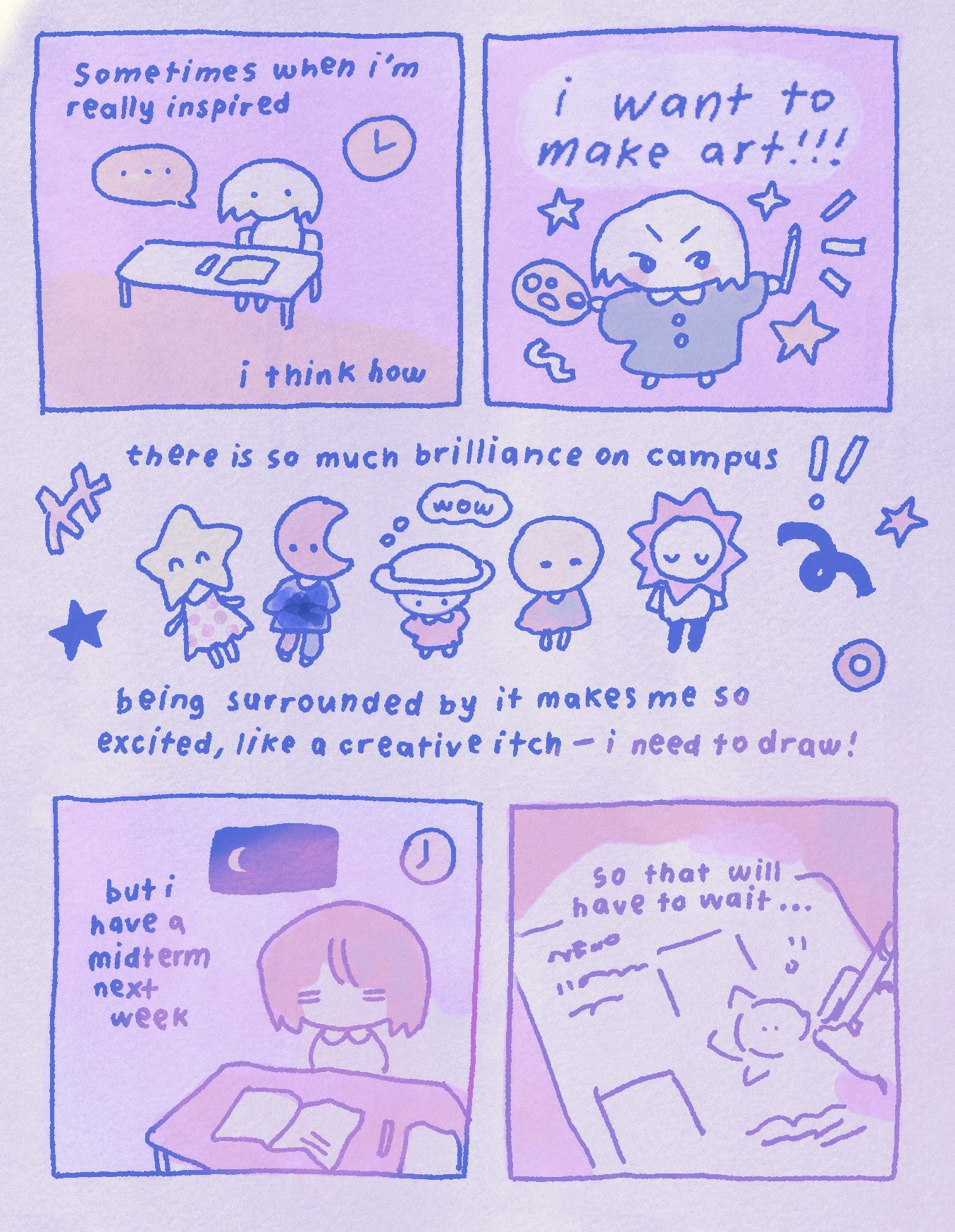

post- mini crossword
Lily Coffman

1. 1-Down minus 1
4. A-lister
6. Mother of Eric and Donald Jr.
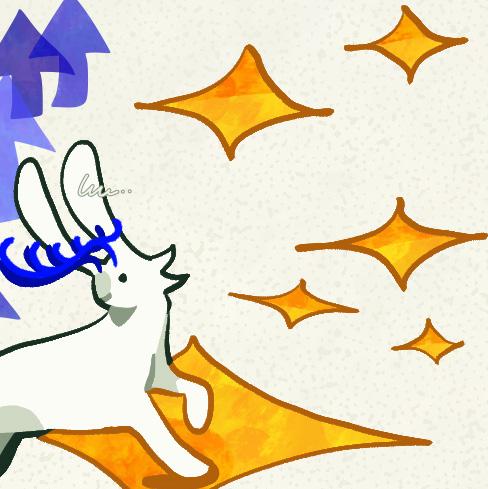
5. Naked Across Down 4 6 5
7. Voice type between alto and baritone
8. Silly and stupid, like this crossword
1. 1-Across plus one
2. Glazer of "Broad City"
3. Only element that starts with X
4. Mets' field
Thank you for reading
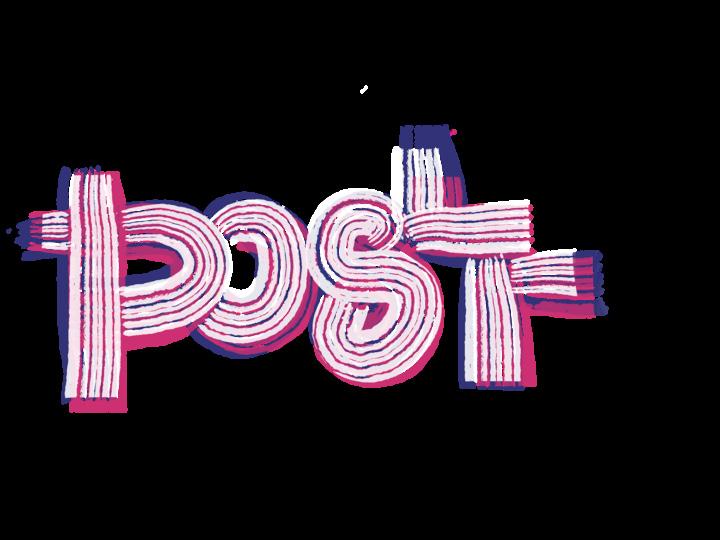
New issues every week.

“I must tell you that I am from Hawai‘i, but I am not Hawaiian. I don’t know how it feels to have the land taken from me. I don’t know how it feels to fight for it back. All I know is that, although this land was never mine, it is the one that raised me. It is the only thing I want to write about. I’m turning my memory into mythology for you.”
— Emily Tom, “home is a place revisited”
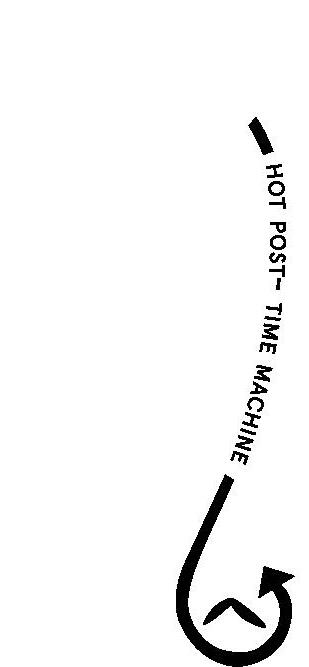

“There are dances that open their arms, reaching out towards the audience until every single droopy-eyed father in the crowd is tapping his foot along to the rhythm—and there are dances that hug in on themselves and whisper some terrible sadness that brings a tear to the most stoic eye.”
— Mack Ford, “a tangle of movement” 10.18.23
EDITOR-IN-CHIEF
Emilie Guan
FEATURE
Managing Editor
Elaina Bayard
Section Editors
Anika Kotapally
Chloe Costa Baker
ARTS & CULTURE
Managing Editor
AJ Wu
Section Editors
Lizzy Bazldjoo
Sasha Gordon
NARRATIVE
Managing Editor
Gabi Yuan
Section Editors
Chelsea Long
Maxwell
Zhang
LIFESTYLE
Managing Editor
Daniella Coyle
Section Editors
Hallel Abrams
Gerber
Nahye Lee
POST-POURRI
Managing Editor
Michelle Bi
Section Editor
Tarini Malhotra
HEAD ILLUSTRATORS
Junyue Ma
Lesa Jae
COPY CHIEF
Jessica Lee
Copy Editors
Indigo Mudbhary
Lindsey Nguyen
Rebecca Sanchez
Tatiana von Bothmer
LAYOUT CHIEF
Amber Zhao
Layout Designers
Emma Scneider
Emma Vachal
James Farrington
Tiffany Tsan
SOCIAL MEDIA
Rebecca Sanchez
Yana Giannoutsos
Yeonjai Song